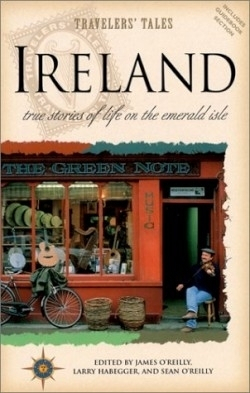Ireland
True Stories of Life on the Emerald Isle
Reading Ireland: True Stories of Life on the Emerald Isle is a surprisingly
authentic substitute for a trip to Ireland, at least temporarily. The amazing
thing about Travelers’ Tales Guides anthologies, collections of stories
centered on different places, is their ability to capture a place in words
alone. The true talent of the Travelers’ Tales editors lies in their ability to
find stories that reveal the unknown aspects of the place.
Ireland does include stories about aspects of the country a traveler might
typically think about: Catholicism-Frank McCourt’s hilarious “Holy Communion;”
cairns and stone churches-David W. McFadden’s evocative “Mr. Looney’s
Archaeological Adventures;” and politics-Scott Anderson’s terrifying “Making A
Killing.” The volume also includes a number of well-known authors; in addition
to McCourt’s story, there’s Maeve Binchy’s “The Chill of Autumn Charity,” about
a small begging boy who takes the rude comments he receives calmly, J.P.
Donleavy’s “The Miracle of St. Bridget,” and Edna O’Brien’s “Escape to
England,” about the pull of Ireland on one of its expatriates, to name a few,
and their stories, often excerpted from previously published work, are great,
as they are expected to be.
The true joy of reading Ireland, however, like the true joy of traveling, comes
from finding lesser-known writers and lesser-known aspects of the country.
The sheer exuberance of leaping, whirling, Irish dancing comes through in
“Wisdom in the Feet,” an excerpt from one of Niall Williams and Christine
Breen’s three volumes on living in Ireland. Their writing on his native and her
adopted country rival that of their well-known counterparts waxing rapturous
about the charms of Provence and Tuscany (only they actually live and work in
the country).
Janine Jones, whose edgy story about a bus ride in Los Angeles appeared in
Travelers’ Tales Guides: America, contributes another disturbing and poignant
snapshot of life unknown to mainstream society to the Ireland anthology. In
“Tea with Mr. Curtain,” she stays at a house in an out-of-the-way village where
she meets an old, well-respected man who feels free to show her the hidden
parts of his psyche, and she accepts him and his need to do so.
The introductory story, “An Unexpected Reception,” by Brian Wilson, describes a
unique arrival to Irish shores-by kayak-with some typical Irish twists.
Wilson’s kayak is mistakenly appropriated by the people who hold the rights to
the wreckage that washes up in the bay near their house, but he is given a
hearty breakfast and warm send-off by the matron of the house-and he gets the
kayak back.
Like Wilson, many of the authors comment on the warmth and hospitality of the
Irish. “Mediterraneans of the North” describes the lives of the lonely
bachelors of the west coast. One has to admire how Susan Hughes, the author, is
able to visit the male friends she has made there without feeling trapped by
their need and desire for a woman. “The Miracle of St. Bridget,” in which an
older, handsome bachelor wishes for what an older, handsome bachelor might be
expected to wish for, shows that Irish hospitality enriches the locals’ lives
as much as the travelers’.
Some of the best stories, while specifically about adventures in Ireland, are
truly about traveling in general, about the value of adjusting to the
surrounding place to absorb it on its own terms. In the short “Cycling to Dun
Aengus,” Tom Mullen describes slowing down to enjoy the pace of the land around
him, allowing the rhythm of the countryside to seep into his body.
Relaxing into a place allows a traveler to see its people as well, not as
charming “types,” but as complex cogs in their country. Being a traveler means
being able to see and accept people as they are, interacting as one chooses.
Looking for the “true face” of Ireland, Rosemary Mahoney finds herself among a
group of young girls eager to examine a young woman outside their own world.
While this is a book of travelers’ stories, so is intended to be mostly about
the perspective of outsiders, it would have been nice to feature some James
Joyce or a Yeats poem or an old legend of Cuchulainn, perhaps in the sidebars
sprinkled throughout the book. Cecil Woodham-Smith’s “The Root of the Troubles”
offers a little Irish history in regard to the centuries-old England-Ireland
conflict, but more, perhaps from the perspective of a traveler, would have been
nice.
As it is, though, this is another wonderful Travelers’ Tales Guide. Irish eyes
are smiling. Eyes are smiling all over the world, and Travelers’ Tales captures
them in book form.
Reviewed by
Celeste Sollod
Disclosure: This article is not an endorsement, but a review. The publisher of this book provided free copies of the book to have their book reviewed by a professional reviewer. No fee was paid by the publisher for this review. Foreword Reviews only recommends books that we love. Foreword Magazine, Inc. is disclosing this in accordance with the Federal Trade Commission’s 16 CFR, Part 255.

